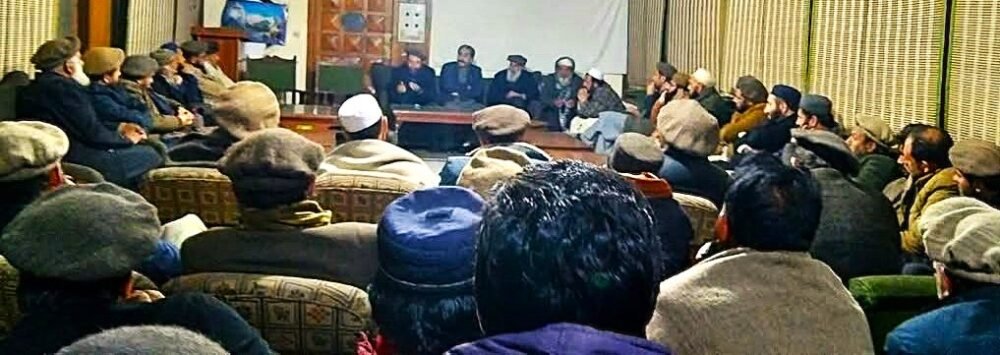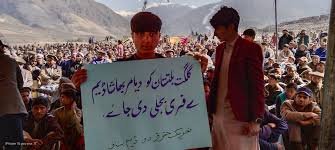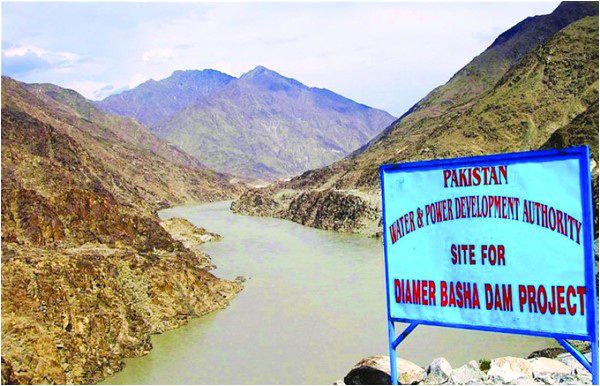High Asia Herald Exclusive
Chilas (Gilgit-Baltistan): Tensions escalate in the mountainous region of Gilgit-Baltistan as the ‘Haqooq Do Dam Banao Tehreek’ (Give Rights, Build the Dam Movement) enters second week of protest sit-in, with organisers threatening a long march to the dam site unless the federal government bends to their demands.
They have also threatened to “bring all of Diamer to a standstill” unless Islamabad’s ministerial committee urgently addressed demands for fair compensation, resettlement, job regularisations and inclusion of affected communities’ representatives in decisions surrounding the contentious Diamer-Bhasha Dam project.
Hundreds of protesters, waving placards reading “Our Land, Our Rights,” “Our Resources, our right”, “give jobs to locals” have brought to a standstill the civic and commercial activities in the region.
The $29 billion dam faces uncertainty as tensions over ancestral land, resources and unfulfilled promises deepen. With protesters refusing to budge and federal negotiators silent, analysts warn of human, ecological and cultural catastrophe.
The organisers of the movement which has united political parties, religious clerics, tribal leaders, and youth groups in an unprecedented show of solidarity, are demanding urgent action on a 31-point charter of demands tied to the project.
They announced on Thursday (Feb 20) that their final plan of action—including KKH blockades, rallies across G-B, or a long march to the dam site—will be unveiled after Friday prayers, following consultations with a 130-member committee.
In response to the protest sit-in, Minister for Kashmir Affairs and Gilgit-Baltistan Amir Muqam announced the formation of a committee to visit the region and oversee the resolution of the protesters’ grievances.
Wapda officials assured that tenders for the water supply project would be issued within two weeks, while a broader strategy was formulated to ensure the timely completion of various development initiatives.
Key demands and strategy
The protesters insisted that the Federal Minister and Secretary for Planning, Finance join the ministerial committee in Chilas to ensure direct engagement with affected residents, rejecting Islamabad-based deliberations as “detached from ground realities.”

Central demands include land settlement payments for 18,000 acres, six canal replacement land for displaced families, immediate release of a household (Chulha) support package to 2,500 allegedly uncompensated families, increase in subsidised wheat quota of the affected families, development of model colony at Harban Das for displaced families, 80% royalty from Diamer Dam and 30% from Dasu Dam for G-B, ensure 40% quota in jobs for local youth.
Negotiations between the movement’s leaders and GB government representatives ended inconclusively with protesters accusing the later of “delaying tactics.”
Wapda claims it has compensated 91% of landowners and completed payments for buildings and markets a decade ago. It attributes delays in remaining cases to “legal complexities” and accuses some families of refusing to vacate properties despite receiving compensation.
Protesters, however, dismiss these claims arguing that the compensation rates fail to reflect current market values. They allege systemic exclusion of communities from land surveys and accuse the state of reneging on promises to provide fertile resettlement land.
“They offer us rocks and deserts while taking our ancestral fields,” said a tribal elder at a recent rally.
Protests galvanise political leaders
The protests have galvanised political leaders across Gilgit-Baltistan and beyond, with speeches emphasising systemic injustice, grassroots resistance, and demands for autonomy.
Baba Jan, a prominent leftist leader and president of the Awami Workers Party Gilgit-Baltistan (AWPG-B) known for his revolutionary struggle and advocacy for marginalised communities, framed the protests as part of a broader struggle against “colonial development models” imposed by Pakistan and global capitalism.



Addressing the participants of the protest sit-in, the other day, he highlighted the injustices and the colonial rule imposed on the disputed region.
Amid fiery slogans, he said: “Today’s ruling elite captures our land, pastures, rivers, and mineral resources and displaces our people for dams and corporate profits. The Diamer Bhasha Dam is not development—it’s dispossession.
Jan who suffered 10 years jail for raising voice for the Atabad disaster affected people spoke with The High Asia Herald: “This dam will drown our valleys, our ancestors’ graves, erase ancient cultural heritages, and devastate ecosystems. We reject ‘development’ that dispossess people of their land and resources.”
“When we resist, they send police and implicate us in trumped-up cases. But our movement grows stronger. The state cannot silence us forever,” he emphasised.
Jan urged progressive and nationalist forces across G-B, Kashmir and Pakistan to amplify the protesters’ demands, linking the dam issue to broader struggles against imperialist designs. He called for international solidarity and urged protesters to channel their anger into a campaign for development, climate justice, and constitutional rights.
He appreciated the pro-people religious clerics, students and youth of Diamer for putting up resistance against state repression.
“Working class people, scholars, youth—all stand together today. Let this unity become a force for political transformation. Our goal is not just compensation, but liberation from colonial rule.”
Professor Aasim Sajjad Akhtar, an activist in a tweet on X microblogging platform said: “While khakis and their puppets further ecocide & dispossession in the name of #GreenPakistan, popular resistance grows. Massive protest against #DiamerBhashaDam in Chilas. Thousands of peasants in Bhit Shah declaring #NoMoreCanalsonIndus.
The people united will never be defeated!
He told The High Asia Herald: “The Haris of Sindh and the people of Gilgit-Baltistan are united. Both face state-backed land grabs masked as ‘progress.’” He emphasised building a joint front against these anti-people projects.
The Awami Action Committee (AAC) Chairperson Ehsan Ali congratulated the people of Diamer for burying the sectarian and other evils.
He stressed the urgency of addressing the 31-point charter of demands.
Ali accused the state of using “delaying tactics,” and dismissed Wapda’s legal arguments as excuses to avoid accountability.
Nawaz Khan Naji, chairman of BNF and a veteran advocate for Gilgit-Baltistan’s self-determination, framed the dam protests as symptomatic of the region’s political disenfranchisement.
“Gilgit-Baltistan is neither a province nor a colony. We are denied representation in Parliament, yet our resources fuel Pakistan’s economy. This dam is theft, sanctioned by our exclusion.
“The state claims our rivers, minerals, and forests. Diamer-Bhasha Dam is another chapter in this loot. We must reclaim ownership of our land and destiny, he stressed.
Progressive Students Federation –PrSF in a statement also condemned the “neocolonial development,” arguing that Gilgit-Baltistan’s struggle mirrors global indigenous movements against extractivism.

Meanwhile people demonstrated unprecedented unity across Hunza and Nager’s political spectrum in support of Diamer’s protesters.
The ‘All Political Parties, Civil Society, and Anjuman-e-Tajiran (traders’ Association), and Hotel Association Hunza on Thursday held a protest rally at Aliabad and expressed solidarity with the Chilas protests and endorsed their struggle for “legitimate rights
Mainstream media coverage
In a February 18, 2025, editorial, Dawn, the leading English newspaper of Pakistan, warned that the standoff risks spiraling into a broader crisis, noting the rare unity among Diamer’s fractious tribal communities.
“The protesters’ demands… are not unreasonable, but neither is Wapda’s stance entirely baseless,” the editorial stated, urging the federal government to act swiftly. It emphasized the dam’s national importance—a $29 billion project critical for water storage and 4,500 MW hydropower—while cautioning against dismissing local grievances as “narrow interests.”
However, activists rebuked the newspaper’s stance misleading and a move to legitimise the colonial rule over the disputed region.
Safiullah Baig, a noted environmental and political activist from G-B rebuked Dawn’s editorial on the dam issue accusing it of promoting a colonial narrative by deliberately obscuring the region’s constitutional ambiguity to reinforce Pakistan’s control over the region.
He claimed Dawn aligned with Pakistan’s “ruling elite,” portraying the dam’s benefits for national development while ignoring its exploitative dimensions, and local risks. This imbalance reinforces a top-down development paradigm, he argued.
While talking to The High Asia Herald, Baig claimed major Pakistani media outlets often mirror state priorities, particularly on strategic projects. He urged them to centre Gilgit-Baltistan’s historical marginalization, resource rights, and environmental vulnerabilities in dam discourse and move beyond colonial-era binaries.
National benefits vs local sacrifices
He challenged the state’s narrative of “national interest” and ownership of the dam. “Diamer Dam does not belong to Pakistan’s ruling elite; it belongs to the people of Diamer,” he claimed rejecting the state’s unilateral control over local resources and asserted communal rights to land and water.
Baig acknowledged the dam’s projected advantages but emphasized their exclusionary nature. The dam is projected to generate 4,500MW of electricity to power cities and industries, extend the lifespan of Tarbela Dam by 35 years; and mitigate floods by storing 8.5 million acre-feet of water reserves.
None of these benefits, he argued, will reach Gilgit-Baltistan. Instead, the region will face environmental risks as construction in a seismically active, narrow valley and the 200km² reservoir could destabilize slopes, triggering landslides, and ecological disruption; the dam will also result in cultural heritage erasure as it will submerge ancient human settlements, and rock carvings, which he termed a “loss of civilization.” Wapda will control surrounding areas for “dam security,” displacing communities as 17,900 acres have been transferred to Wapda. He questioned whether this land was truly “government-owned” or communal property seized without consent.
Wapda had pledged to build nine model villages for displaced residents. Baig questions “have these villages been constructed?”
A test for development justice
The protests underscore a deepening mistrust between Gilgit-Baltistan’s residents and the Pakistani state. The region’s ambiguous constitutional status fuels perceptions of exploitation.
With the protest movement threatening a long march to the dam site, the ball lies in the federal government’s court. Protest leaders demand transparency. “We want signed agreements, not verbal assurances,” said a youth organizer.
Meanwhile, Wapda insists construction cannot stall indefinitely, citing the dam’s role in mitigating Pakistan’s water and energy crises.
For now, Chilas remains a tinderbox, its valleys echoing with slogans for justice—and warnings of revolt.

The High Asia Herald is a member of High Asia Media Group — a window to High Asia and Central Asia

